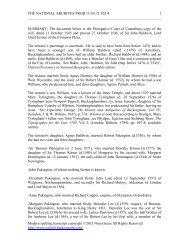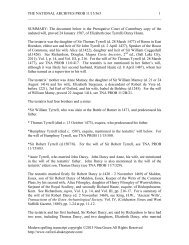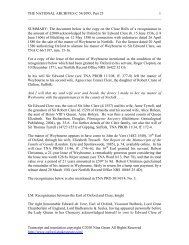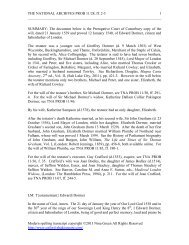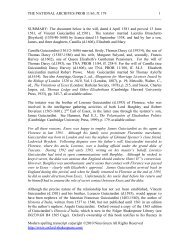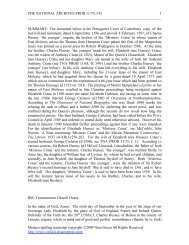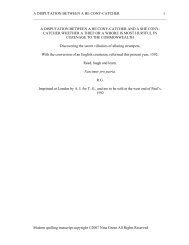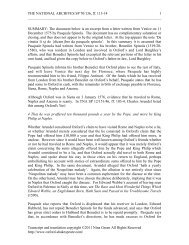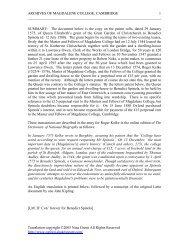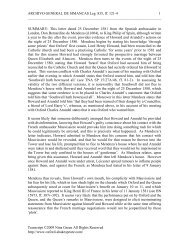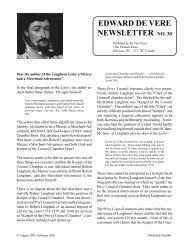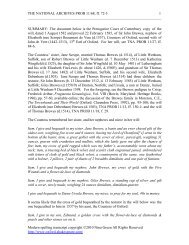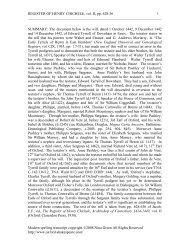Kathman refutation - The Oxford Authorship Site
Kathman refutation - The Oxford Authorship Site
Kathman refutation - The Oxford Authorship Site
You also want an ePaper? Increase the reach of your titles
YUMPU automatically turns print PDFs into web optimized ePapers that Google loves.
FALSE PARALLELS IN DAVID KATHMAN’S ‘DATING THE TEMPEST’ 2<br />
________________________________________________________________________<br />
<strong>The</strong> Bermudas be broken islands, five hundred of them in manner of an archipelago (at<br />
least if you may call them all islands that lie, how little soever, into the sea and by<br />
themselves) of small compass, some larger than other, as time and the sea hath won from<br />
them and eaten his passage through; and all now lying in the figure of a croissant, within<br />
the circuit of six or seven leagues at the most. (Wright, p. 17)<br />
This crescent-shaped group of five hundred islands, large and small, is significantly<br />
different from the single isolated island in <strong>The</strong> Tempest. Would Shakespeare have used a<br />
tract mentioning a group of five hundred islands as a source for a play about a single<br />
isolated island?<br />
Similarly, the flora and fauna in Bermuda as described by Strachey and Jourdain are<br />
markedly different from the flora and fauna mentioned by Shakespeare in <strong>The</strong> Tempest.<br />
Would Shakespeare have used tracts discussing such unusual plants, animals, fish, and<br />
birds as simerons or wild palms, palmettos, prickled pears, mulberries, wild hogs,<br />
silkworms, angel-fish, bonitos, sting rays, whales, sharks, swordfish, cormorants, and<br />
birds which lived in holes in the ground as sources for a play in which he mentions none<br />
of these species?<br />
Perhaps most importantly, there is a vast difference between the circumstances of the<br />
wreck of the Sea Venture as described in the Strachey letter and the Jourdain account,<br />
and the wreck of the ship in <strong>The</strong> Tempest. <strong>The</strong> Sea Venture sprang a huge leak which<br />
filled the ship with water five feet deep, requiring constant bailing for three days and four<br />
nights. <strong>The</strong> ship was not under sail, and was merely wallowing in the storm-tossed ocean<br />
until land was sighted on the fourth day and the sailors deliberately ran it aground in<br />
Bermuda, where it wedged itself between two rocks, giving the sailors an opportunity to<br />
break out the small boats and row everyone aboard, as well as some provisions and<br />
equipment, safely to shore. In contrast, as Lord Mulgrave has shown (see below), the<br />
ship in <strong>The</strong> Tempest is under sail attempting to round a point of land when it hits a rock<br />
and is ‘dashed all to pieces’. At the same time, Ariel creates a magic phenomenon on the<br />
ship which is so terrifying that all the passengers jump into the sea and swim for their<br />
lives. <strong>The</strong>re is absolutely nothing in common between the two accounts. <strong>The</strong>y are<br />
strikingly different and unique in their respective details. It is impossible that<br />
Shakespeare could have used the one as a ‘source’ for the other.<br />
<strong>The</strong>re is also a significant difference between the plots described by Strachey and<br />
Jourdain in Bermuda, and the plots in <strong>The</strong> Tempest. <strong>The</strong> survivors in Bermuda were split<br />
by dissension from the outset because some of the survivors immediately began building<br />
ships to enable everyone to sail on to their original destination, the Jamestown colony,<br />
but many of the others preferred to remain in Bermuda, where there was a pleasant<br />
climate, plenty of food, and relative independence. All three plots in Bermuda centered<br />
around schemes by some of the survivors to remain on the island. <strong>The</strong>se schemes pitted<br />
one group of survivors of the shipwreck against the rest of the group, and were nonviolent<br />
in nature, apart from some vague remarks made by Strachey about possible<br />
violence in connection with the third such plot (see below). In <strong>The</strong> Tempest, none of the<br />
survivors wishes to remain on the island, and the plots which are hatched are of an<br />
© 2005 Nina Green All Rights Reserved<br />
http://www.oxford-shakespeare.com/



